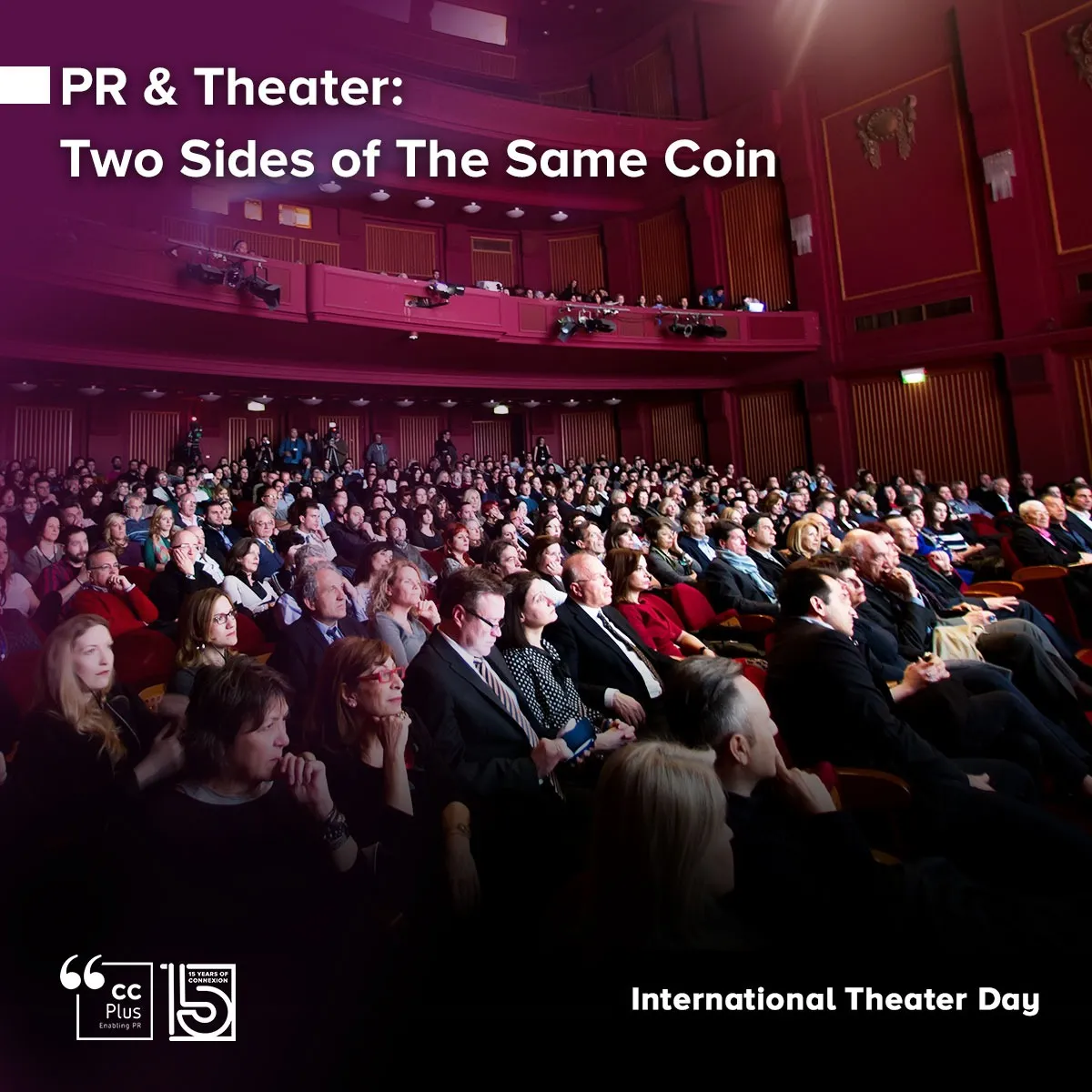PR & Theater: Two Sides of The Same Coin
On International Theater Day, we’re looking into how PR and Perfomance Art are closer than they are apart.

Live theater and PR are more alike than different.
A play takes place in a theater, where actors perform on stage, engineers are backstage, playwrights write and directors direct. Putting ona play takes a village, yet what is a play without an audience?
A PR initiative is similar. It takes place in an intangible theater, where stories are written, the press is engaged, a client’s reputation is at hand, all to paint a narrative. A narrative which will change opinions, affect decisions, and spread information.
PR is not only limited to be a promotional marketing tool, it’s a comprehensive action that curates an entity’s policy, mission & vision, product & servies to the public. PR decisions influence a client’s ecosystem including employees, customers, investors, the media or other stakeholders. While PR may be intangible, it’s impact possesses great influential power.
It’s fascinating how the world of stage performance relates closely to PR. Unlike Film Production where there is more space for errors, live theater is prepared for and practiced to be performed once where there uncertainties forseeable.
Similarly to Performance Art, PR campaigns follow common steps in preparation to one big unfolding. That’s why on International Theater Day, we’ve compiled the many ways in which these two worlds are connected.
Before The Big Show
What does it take to put on play? The list can be summarized to the playwright, the actors, backstage staff, the audience and a venue. The playwright can be defined as the very essence of the play since they are the one writing the script. In PR, this is not so different.
The Playwright and The PR Manager
Both the playwright and the PR Manager share interchangeable traits. The playwright needs to be creative in the story he tells to his audience, so does the PR communicator. The two roles work to create a dialogue between actors and the audience. In the field of communications, these actors include spokespersons, the media and the PR managers themselves. The impact created from a play or a campaign results from creativity.
Creativity
When was the last time you saw a great show and thought it looked like nothing you’ve seen before? That’s what well crafted and targeted PR campaigns feel like. Telling timeless narratives allow for unique relationships between the campaign subject and the audience, it becomes a special intangible relationship between the public, the client and the press. This relational triangle is constructed thanks to the creativity of PR communications. It is then when you know you won’t be seeing the same “show” twice.
Storytelling
Plays tell stories, PR campaigns tell narratives. They both require storytelling skills. When the goal is to impact, the storyteller keeps in mind the audience he’s narrating to.
Just like audiences of different ages can perceive theater dialogues differently, PR communicators should keep in mind the targeted audience’s values, structure, opinions and interests. This allows for transparent and honest communication to create consensus and connections with the public.
Similarly to knowing your audience, a playwright keeps in mind which performers is he writing for, knowing who your performers are, allows you to play to their strengths. In the world of communications and PR agencies, campaigns are drafted in accordance to clients. Entities requesting PR come in all differents shapes and tell different stories. That’s why getting to know these organizations beforehand is part of the process of a PR communications strategy.
The Opening Night

The Chicago cast of Traces.
It’s opening night, and the actors are in position. The audience is seated and it’s minutes before the first act.
In another world, it’s minutes before a big event, you, the PR manager are greeting public figures, coordinating the media, making sure the audience is seated before you see your work unfold.
PR as a theatrical performance
Would you consider communication strategies as performances? With many players unified for the same end-goal, some could answer yes.
The performers in a play practice to act on a live stage. PR communicators brainstorm to prepare press releases, work closely with spokespeople, target selected media and audience. Speaking to the public is the equivalent of the opening night.
In PR, what matters most is reputation. A company’s communications with public opinion is composed of 4 elements: corporate identity (organizational symbols), insitutional advertising, customer service programs and publicity about the company and its products & services.
Therefore what matters is not the company image but its reputation which includes employee opinions, behaviors, management culture, investors’ opinions, customer opinions, media reviews and other public stakeholder statements about the organization. These views influence the company’s image and consequently its reputation, making reputation management crucial.
Great, strong and stable reputations are difficult to built yet easy to be broken. That’s why the product of PR campaigns just like in theater is incredibly precious. When deliivering communications to the larger public, reputation is at stake and the your only tool of navigating through public opinion is communication.
What Can Go Wrong, Will Go Wrong
The first of Muruphy’s law states “anything that can go wrong, will go wrong”. Emergencies happen, unpredictable changes can occur, but the show must go on!
The day of a play’s premiere, actors can not show up, costumes can go missing, props could break on stage, actors could forget their lines or audiences could dully react to the show. The same is true in PR.
That’s why it’s important for PR communicators, managers and executives to master the ability of thinking on your toes. Accidents are difficult to avoid yet the response to them, if effective resolves them!
Creating Impact
Changing the Narrative
What’s more important than the campaign itself, is the level of influence it has. Communicators hold the power of storytelling, that’s why notable impact is based on the strong construction of their narratives.
A good story is an honest story. Just like in acting, a powerful performance is one where the actor fully believes in his role just as PR managers as well. An audience connects and emphasizes with a sincere narrative. However, an honest story can also deal with unorthodox topics. It is sometimes honest to change the narrative and challenge existing beliefs and ideas when it conveniently serves a campaign.
Yet, the impact should not only be external. Just like the relationship between the playwright and the director, internal PR players of a campaign should be just as inspired. As messengers, they are the root of all communications.
Controversial Topics
As we mentioned earlier, emergencies can arise during and after a show. Campaign topics can be controversial, triggering and unconventional and it is then that PR managers use their crisis communication tools to stere the narrative. In theater, a play can receive negative reviews from critics, the audience, and the general public, it is then up to the playwright to choose how to respond.
Press, Press, Press!
When mitigating public opinion, the press is your steering wheel. Challenging narratives and thematics can surface just like in performance art. Being creative and progressive can come at the cost of being ill-perceived, but that is the power of theater and public relations, to give meaning and take charge of the narrative and address these issues through the media.
Moreover, not all news should be shared to all media. Media planning, strategies and selections are just as important to tell effective stories and target selected audiences. PR managers consequently pursue media relations as well.
The fundamental goal of public relations is to maintain friendly relations with the public, hence the industry name and not to be used for negative propaganda. Public relations should aim for information transparency through deliberate and organized plans.
Our play comes to and end, and to conclude, public relations, are more than an advertising tool. Theater teaches us that PR holds the power of storytelling, creativity and influence through strategic planning.
The PR manager and the Dramatist are more alike than different. Their jobs inherently come with the need to be creative, storytellers and good communicators. They communicate to their public as well as their “troupe”.
As storytellers in PR or in theater, obstacles occur at the cost of triggering topics. But that is when these narrators are called to be transparent. The media is their essential asset in steering through negative reviews, opinions, news and create lasting impact.






